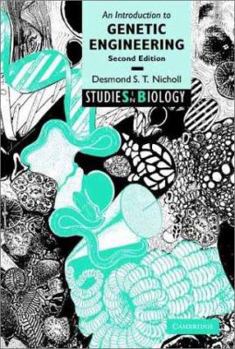An Introduction to Genetic Engineering
Select Format
Select Condition 
Book Overview
Des Nicholl presents a new, fully revised, and expanded edition of his popular undergraduate-level textbook. The book retains many of the features of the original edition and still offers a concise... This description may be from another edition of this product.
Format:Paperback
Language:English
ISBN:0521004713
ISBN13:9780521004718
Release Date:February 2002
Publisher:Cambridge University Press
Length:304 Pages
Weight:1.14 lbs.
Dimensions:0.5" x 6.1" x 8.9"
Customer Reviews
4 ratings
you need this in your bookshelf
Published by Thriftbooks.com User , 16 years ago
This is a great book for college students. Probably the best textbook of genetic engineering I've ever read ! I'm already a graduate student majored in plant science, but I still find this book quite useful in giving me an general and clear conception about genetic engineering. My favorite part is the concept maps at the end of each chapter !!
A brief overview of gene technology
Published by Thriftbooks.com User , 21 years ago
First off, I would have given this book 5 stars if value was the main consideration. You can't beat the price for what you are getting with this work. It provides a very concise overview of modern gene technology, though that conciseness is the underlying drawback of this text. Another thing I didn't like about this text is that that everything is in black and white. With today's printing capabilities, B/W is sub-standard. Although, I must express that even with the limited resources put into the printing, the diagrams are well thought out and the graphical explanations are very well delivered considering there is no color to work with. As mentioned above, for a compact text that weighs next to nothing compared to a full text-book you can't argue against its value.This book is divided into three parts. Part I covers the basic gene technology principles. Part II deals with the methods of rDNA technologies. And Part III discusses some applications of rDNA with some minor references to non-rDNA biotechnologies for comparison purposes. Part I and Part II seem somewhat dry, especially with the terseness involved with cramming the whole subject into such a small book. It takes a lot of interest in the subject to keep the attention span. It also is a bit difficult to follow at times and re-reading parts and perhaps referencing external texts may be necessary to obtain a good comprehension of the material at hand. One fantastic feature is that the author provides a "summary chart" at the end of each chapter. The educational impact of this technique is remarkable and I wish this was used more in many other texts. Part III is where the juicy material is covered. After all the foundation is laid, Part III makes for easy reading and brings to light the knowledge you gain from the former parts. It gives a brief overview of some of the different applications of gene technology as well as discusses societal impact and influence (perhaps the major determinant of the fate of biotechnology).Readers of this book should have some background knowledge of genetics or molecular biology. That would help overcome the terseness of the presentation material. Overall, this book provides a decent academic overview of the subject without the sidetracking toward the many examples and specific details contained in full texts.
Excellent Overview
Published by Thriftbooks.com User , 22 years ago
Nicholl covers every pertinent aspect of this fascinating field of science and engineering in this book in a clear and comprehensible way. His use of concept maps to summarize the key concepts in each chapter is a tremendously effective tool.Nicholl approaches this subject in a schematic way. That is to say, he makes considerable use of idealized diagrams to explain the many components and characteristics of genetic materials and processes. The terminology will be a challenge for non-geneticists, but Nicholl has included a fairly comprehensive glossary of terms at the end of the book.I highly recommend this text to anyone interested in understanding the basics of GE and its implications for our world.
Excellent for the non-biology expert
Published by Thriftbooks.com User , 24 years ago
I came across this book searching for good introductory texts to be used as companions in a bioinformatics course intended for an audience of graduate students in computer science at the University of Chicago. This is definitely an outstanding text for this purpose. It's genetic engineering in a nutshell. Each chapter is summarized at its end by a "concept-diagram" that connects all the essential information in that chapter (I wish other authors could do the same with their books). The book is divided in eight chapters, spanning over 165 pages approximately. It covers basic molecular biology (gene organization, expression), manipulation of nucleic acids (labelling, hybridisation, electrophoresis, and sequencing), restriction, modifying, and joining enzymes, vector techniques, cloning, recombinants, and applied issues (making proteins, transgenics, etc).





